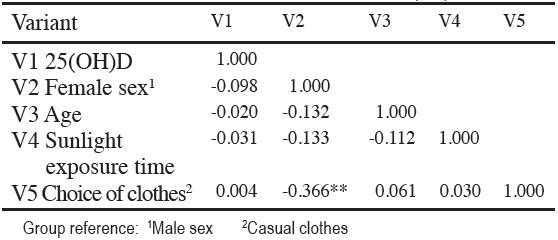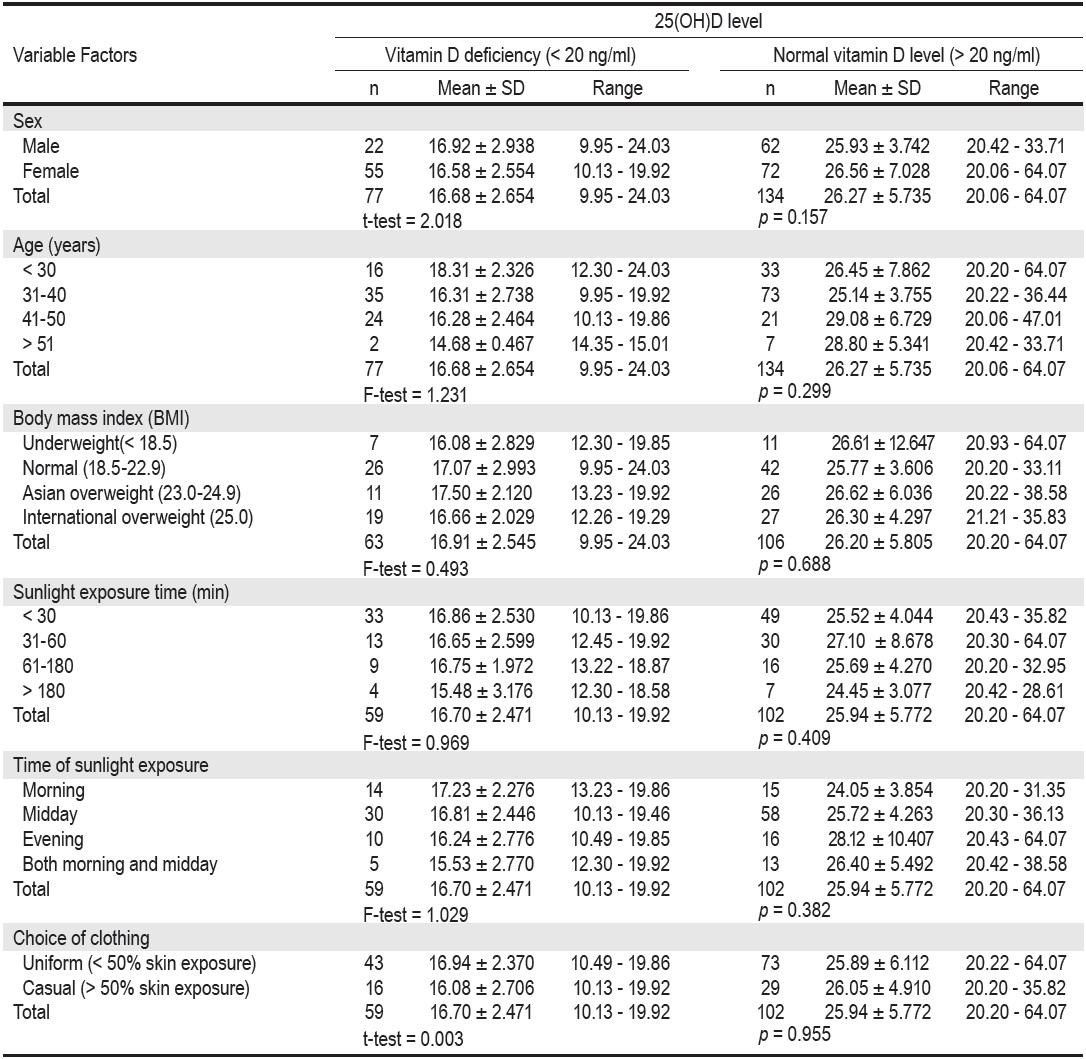Vitamin-D is a nutrient known for its role in prevention and treatment of rickets, osteoporosis, myopathy and lower incidence of fractures. The epidemiologic evidence indicates a relation between inadequate vitamin D levels and such diseases as cancer,1 diabetes,2,3 hypertension,4 rheumatoid arthritis,5 heart failure,6 acute myocardial infarction,7 dementia and Alzheimer’s disease.8 Although the causative relation between vitamin D deficiency and these diseases is yet to be defined, so far the epidemiologic evidence strongly advocates for the medical community to look for better prevention approaches to reduce vitamin D deficiency. Vitamin D is a fat soluble vitamin, scarcely found in ordinary food. There are two forms of vitamin D, Vitamin D2 (ergocalciferol) and vitamin D3 (cholecalciferol). The human body obtains vitamin D from 2 sources;Source 1: By exposure to the ultraviolet B (UVB) of sunlight, the skin transforms subcutaneous cholesterol called 7-dehydrocholesterol into vitamin D3 (cholecalciferol). Source 2: From food; for instance, this list of high vitamin D content as a percentage of daily value (DV),9 Cod liver oil 1 tablespoon (340%DV), A piece of salmon 3 ounce (199% DV), Sun-dried mushroom 3 ounce (100% DV) and One egg (vitamin D is in yolk) 6% DV, etc.
Previously there was a false belief that vitamin D2 was not as effective as vitamin D3 in transforming into 25(OH)D. This belief was proved wrong by one study10 which showed that vitamin D2 is as effective as vitamin D3 in transforming into 25(OH)2D. Vitamin D levels can be measured in two units, ng/ml and nmol/ml, where 1 ng/mL equals to 2.5 nmol/ml. The normal value of vitamin D is a matter of controversy. The Institute of Medicine (IOM) had issued latest definition of vitamin D level as follows:11
nmol/L** ng/mL* Health status
< 30 td=””> < 12 td=””> • Vitamin D deficiency
35-30 12-20 • Inadequate vitamin D to maintain health
≥ 50 ≥ 20 • Adequate vitamin D
> 125 > 50 • Probably too much vitamin D
In Thailand, to date there is a paper to support what constitutes normal vitamin D levels of the Thai population.12 The 2008, the Thai Population Health Survey13 arbitrarily categorized vitamin D level as follows:
This study used a level of 25(OH)D of < 20 ng/ml as a cut-off point for vitamin D deficiency, based on an IOM report. There are only a few reports on vitamin D levels of the Thai population. of these did not use homogenous standard laboratory methodology. An early study worth mentioning was done with 105 post-menopausal urban women by Konkan University12 in the year 2000 which reported average vitamin D levels as 33.24 ng/ml, while 66.3% of the subjects had vitamin D levels less than 35 ng/ml.
The 2008 Thai Population Health Survey had reported vitamin D levels of 2,641 Thais of all sex and age (including children) that 5.7% of the subjects were vitamin D deficient, while 45.2% of them had inadequate vitamin D 45.2% and 49.1% of them had normal vitamin D level (> 30 ng/ml). Another study was done with 217 nurses of The Royal Irrigation Hospital published in 2012.14 This study which used high-performance liquid chroma- tography assay (HPLC) in assessment of blood levels of vitamin D reported that 49.8% of these nurses were vitamin D deficient (< 20 ng/ml), 45.6% of them had inadequate vitamin D (21-30 ng/ml) and 4.6% of them had normal vitamin D levels (> 30 ng/ml). Such results are surprisingly different from the 2008 Thai Population Health Survey Report. This raises the question of what constitutes the actual figure of vitamin D levels in the Thai population?
This study is a descriptive cross section study designed to determine vitamin D levels of workers in one business organization. All participants answered the question sheet and had a blood sample drawn and submitted for 25(OH)D level checking at Phyathai2 hospital laboratory.The laboratory electro-chemiluminescence immunoassay method (Roche, modular analytics 170, cobase 601) was used to evaluate 25(OH)D level (inter-assay and intraassay coefficients of variation (CV) of 3.5-13.1% and 1.7-1.8% respectively). The obtained result then was used to analyze the relation between 25(OH)D and age, sex, sunlight exposure and choice of clothing, using Pearson Coefficient at p value less than 0.05.
Part 1: General information from the samples
Of 211 volunteers, 127 (60.25%) were female, 84 (39.8%) were male. The youngest volunteer was 23 years old. The oldest volunteer was 63 years old. The average age of all volunteers was 35.8 years (Mean = 35.8, SD = 7.5) Most (51.2%) of the volunteers were between 31-40 years old. About a fourth of them (23.2%) were less than 30 years old. About a fifth of them (21.3%) were 41-50 years old. The rest (4.3%) were more than 50 years old.
Of all 211 volunteers, 169 reported their body mass index (BMI) value. The lowest BMI value was 15.7; the highest BMI value was 36.7. The average BMI value was 23.0 (Mean = 23.0, SD = 3.8). Of these 40.2% of them had normal BMI (18.5-22.9) while 27.2% of them were overweight by international standards (> 25.0), 21.9% of them were overweight by Asian standards, and 10.7% of them were underweight (< 18.5).
Of all 211 volunteers, 168 reported their weekly exercise routine. One hundred and seven of them (63.7%) did not do exercise regularly while 61 of them (36.3%) did exercise regularly. For those who did exercise regularly, 22 (36.1%) exercised once a week while 15 (24.6%) exercised twice a week, 14 (23.0%) exercised three times a week, 5 (8.2%) exercised four times a week, 2 (3.3%) exercised five times a week and another 2 (3.3%) exercised seven times a week. The shortest time spent exercising was 10 minutes. The longest time spent exercising was 360 minutes. The average time spent exercising was 64.4 minutes (Mean = 64.4, SD = 58.2).
Of all 211 volunteers, 161 answered questions on sunlight exposure levels. Eighty eight respondents (54.7%) had been exposed to midday sunlight, 29 (18.0%) of them had been exposed to morning sunlight, 26 (16.1%) of them had been exposed to evening sunlight and 18 (11.2%) of them had been exposed to both morning and midday sunlight. The shortest length of time of sunlight exposure was 3 minutes while the longest was 480 minutes. The average exposure time was 70.7 min (Mean = 70.7, SD = 81.1). Most (116 or 72.0%) of the volunteers wear uniform and this exposes less than 50% of skin to sunlight while 45 (28.0%) of them wear casual clothes which expose more than 50% of skin to sunlight. The 25(OH)D level of all volunteers is depicted in Table 1.
About a third of all respondents (77 persons, 36.5%) were vitamin D deficient (< 20 ng/ml). The lowest level of 25(OH)D was 9.950 ng/ml while the highest level was 64.07 ng/ml. The average level of 25(OH)D was 22.769 (Mean = 22.769, SD = 6.695).
Part 2: Analysis of factors related to vitamin D deficiency
The analysis of co-relation between 25(OH)D and age, sex, sunlight exposure time and choice of clothes, using Pearson Coefficient at p value less than 0.05 showed that there was no relation between 25(OH)D levels and age, sex, sunlight exposure time and choice of clothes.
Table 1: Percentage of volunteers by 25(OH)D level.

Table 2: Pearson correlation matrix of variables for 25(OH)D level.

Table 3: 25(OH)D level by variable factors (n = 77).

There are three studies of vitamin D levels in Thai population worth mentioning:
From all the above three studies, a significant per- centage of the Thai population (> 36.5%) had inadequate vitamin D levels (20-30 ng/ml) while at least 5.7% of them were vitamin D deficient (< 20 ng/ml.) This figure raises concern about the adoption of health promotion and disease prevention strategies for those diseases which are related to vitamin D deficiency. Such strategies may include screening vitamin D level for all those who have risk factors of vitamin D related diseases, including osteoporosis and a supplement of vitamin D if indicated.
Two hundred and eleven adults from the working Thai population included into this study had average vitamin D levels (25(OH)D) as 22.769 ng/ml (Mean = 22.769,SD = 6.695). Of these, 63.5% had normal vitamin D levels (20 ng/ml up) and 36.5% were vitamin D deficient (< 20 ng/ml).The lowest vitamin D level in this study was 9.95 ng/ml,the highest level was 64.07 ng/ml. The vitamin D level of this population was not related to age, sex, sunlight exposure and choice of clothing worn by the subjects.
Conflict of interest statement
The authors claim no conflict of interest associated with the manuscript.
This work was supported by a research grant from The Phyathai2 Hospital and from Roche Diagnostic (Thailand) Co. Ltd.
Statement of Authorship
Dr. Sant Chaiyodsilp had the primary responsibility for the research design, supervised the execution of the study, and wrote the manuscript except for the statistical analysis section. Ms.Tanavee Pureekul prepared and managed the study work process and organized the data collection. Ms. Yuphin Srisuk supervised the laboratory test for 25(OH)D of all volunteers. Ms. Cholpatsorn Euathanikkanon performed statistical analyses and out- come assessments and wrote the statistical part of this manuscript. All authors read and approved the final manuscript.